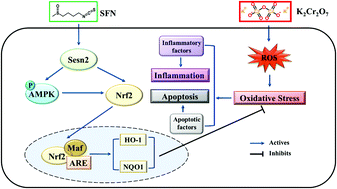Sulforaphane attenuates hexavalent chromium-induced cardiotoxicity via the activation of the Sesn2/AMPK/Nrf2 signaling pathway
Abstract
Hexavalent chromium (Cr(VI)), the most toxic valence state of chromium, is widely present in industrial effluents and wastes. Sulforaphane (SFN), rich in Brassica genus plants, bears multiple biological activity. Wistar rats were used to explore the protective role of SFN against the cardiotoxicity of chronic potassium dichromate (K2Cr2O7) exposure and reveal the potential molecular mechanism. The data showed that SFN alleviated hematological variations, oxidative stress, heart dysfunction and structure disorder, and cardiomyocyte apoptosis induced by K2Cr2O7. Moreover, SFN reduced p53, cleaved caspase-3, Bcl2-associated X protein, nuclear factor kappa-B, and interleukin-1β levels, and increased Sesn2, nuclear factor erythroid 2-related factor 2 (Nrf2), heme oxygenase-1, NAD(P)H quinone oxidoreductase-1, and phosphorylated adenosine 5′-monophosphate (AMP)-activated protein kinase (AMPK) levels. This study demonstrates that SFN ameliorates Cr(VI)-induced cardiotoxicity via activation of the Sesn2/AMPK/Nrf2 signaling pathway. SFN may be a protector against Cr(VI)-induced heart injury and a novel therapy for chronic Cr(VI) exposure.



 Please wait while we load your content...
Please wait while we load your content...